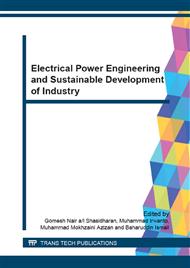[1]
H. Barot and K. Bhattacharya, Optimal Reactive Power Planning and Compensation Effects on Transmission Loss Component, in Power Engineering Society General Meeting, 2007. IEEE, 2007, pp.1-7.
DOI: 10.1109/pes.2007.386161
Google Scholar
[2]
P. Narayana Prasad, et al., Optimal Location and Initial Parameter Settings of Multiple TCSCs for Reactive Power Planning using Genetic Algorithms, in Power Engineering Society General Meeting, 2004. IEEE, 2004, pp.1110-1114, vol. 1.
DOI: 10.1109/pes.2004.1373013
Google Scholar
[3]
R. A. Schlueter, A Voltage Stability Security Assessment Method, IEEE Transaction on Power System, vol. 13, pp.1423-1438, vol. 2.
Google Scholar
[4]
T. Yi, et al., A New Congestion Management Method Considering Voltage Stability Under Electric Market, in Electric Utility Deregulation and Restructuring and Power Technologies, 2008. DRPT 2008, Third International Conference on, 2008, pp.567-571.
DOI: 10.1109/drpt.2008.4523470
Google Scholar
[5]
K. Mwanza, Congestion Management: Re-dispatch and Application of FACTS, Master of Science, Department of Energy and Environment, Chalmers University of Technology, Goteborg, Sweden, (2006).
Google Scholar
[6]
J. Kabouris, C.D. Vournas, S. Efstathiou, G.A. Manos, G.C. Contaxis, Voltage Security Considerations in an Open Power Market, International Conference on Electric Utility Deregulation Restructuring and Power Technologies, London, 2000, p.278–283.
DOI: 10.1109/drpt.2000.855677
Google Scholar
[7]
A. Berizzi, M. Merlo, Y.G. Zeng, P. Marannino, P.A. Scarpellini, Determination of N − 1 Security Maximum Transfer Capability Through Power Corridors, IEEE PES Winter Meeting, Singapore, 2000, p.1739–1744.
DOI: 10.1109/pesw.2000.847615
Google Scholar
[8]
C.D. Vournas, Interruptible Load as a Competitor to Local Generation for Preserving Voltage Security, in Power Engineering Society Winter Meeting, 2001, p.236–240.
DOI: 10.1109/pesw.2001.917041
Google Scholar
[9]
I. Musirin, New techniques for voltage stability assessment and improvement in power system, Doctor of Philosophy, Faculty of Electrical Engineering, University Technology MARA Shah Alam, Selangor, (2003).
Google Scholar


